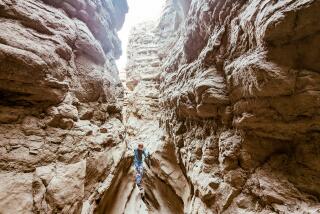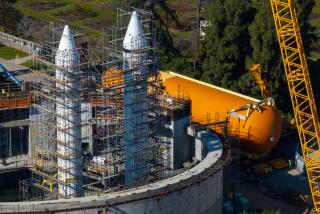Hueco Tanks Historical Park in Texas : Rock Climbers Fly South for the Winter
- Share via
HUECO TANKS STATE HISTORICAL PARK, Tex. — From the ground, the rocks resemble monumental brown warts. From the air, they look like 400-foot-tall mounds of chocolate fudge that were spilled on the desert floor and left to crack in the sun.
From the viewpoint of rock climbers from the north, the granite lava intrusions at Hueco Tanks offer a warm-weather challenge.
During the last couple of winters, hundreds of rock-climbing enthusiasts have converged on the 860-acre park 35 miles east of El Paso to indulge in the increasingly popular sport.
They come from all over the world. Most of the U.S. rock-climbing meccas, such as Yosemite National Park and the Shawangunk Mountains near Poughkeepsie, N.Y., are too cold and snowy to visit from November to March.
Francois Roy, a 24-year-old French Canadian who came to Hueco Tanks recently with two other students from the University of Laval in Quebec, said Hueco Tanks “is well known all over the world. It’s the warmest good place in North America.”
“There’s just a couple of good places in the United States for winter climbing,” said David Groth, 26, of Milwaukee as he strapped a harness around his waist one cool afternoon. “Right now, Hueco Tanks and Joshua Tree (National Monument, near Los Angeles) are the most popular.”
Like most climbers, Groth and his companions are thin, with sleek, hard muscles. Their wiriness betrays little of the stamina it takes to support one’s full weight by the first joints of four fingers for several minutes or the strength it takes to hold onto the rock with hands and feet while climbing with one’s back to the ground.
Rock climbing routes are shorter than those for mountain climbing. But rock climbers, like mountain climbers, use specialized equipment for the job.
Rock climbers rate routes from 5.1 (extremely easy) to 5.15 (impossible for the vast majority of climbers). The number 5 means that technical equipment--the harnesses, ropes and such--are necessary. The most difficult climb at Hueco Tanks is the Gunfighter, rated 5.13.
The three rock masses at Hueco Tanks were created about 34 million years ago when molten rock intruded into a softer, overlying layer of rock. The softer rock eroded, exposing three rounded brown lumps of granite that reach a height of 400 feet.
The weathering process left hundreds of depressions in the rocks, called huecos --Spanish for hollows. Each hueco (pronounced way-co) holds rainwater, and desert animals take advantage of the miniature oases.
Ancient man was attracted to the otherworldly rocks and the water they held. About 6,000 years ago, primitive inhabitants began drawing pictographs on the rocks and on the walls of adjacent caves. About 5,000 pictographs have been found, and the park was established to protect them.
It’s difficult to prevent climbers from defacing the pictographs, intentionally or accidentally, park superintendent Robert Miles said.
For example, climbers put chalk on their hands to keep them dry so they can maintain their grip. First, the park banned white chalk because it marred the brown rock. When climbers switched to brown chalk, it soon became apparent that rains would not wash it off, and the rocks were permanently defaced. Now climbers are asked to use white chalk.
The most serious problem, Miles said, is the use of bolts, which climbers screw into the tops of rock formations for threading safety ropes.
Bolts are banned from Hueco Tanks. Yet, all the major climbing routes have bolts embedded in the rock along the way. Park personnel and climbers have struck an unspoken truce: Rangers won’t remove bolts, and climbers won’t drill any more of them.
More to Read
Sign up for The Wild
We’ll help you find the best places to hike, bike and run, as well as the perfect silent spots for meditation and yoga.
You may occasionally receive promotional content from the Los Angeles Times.






